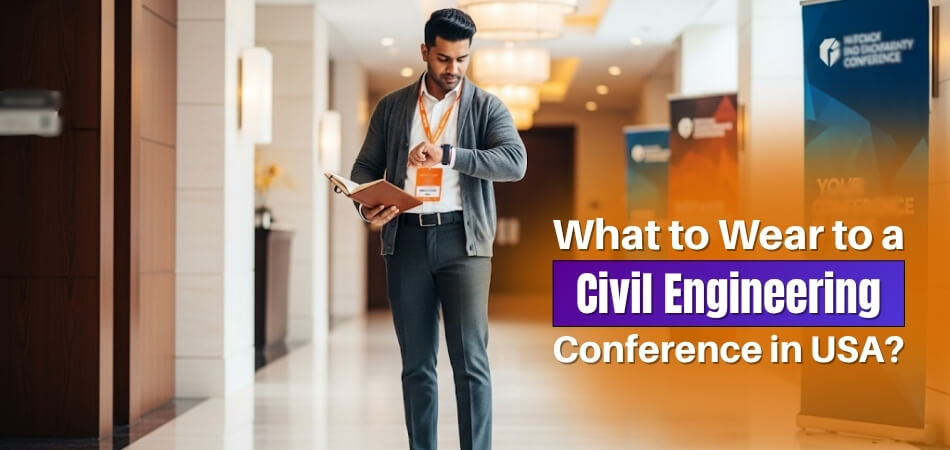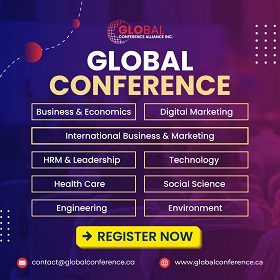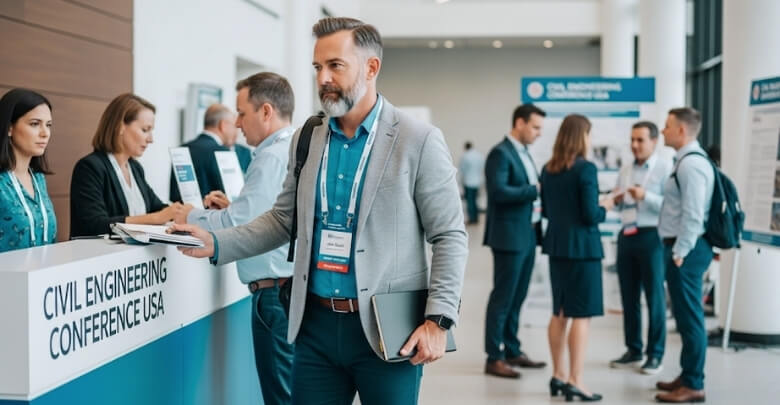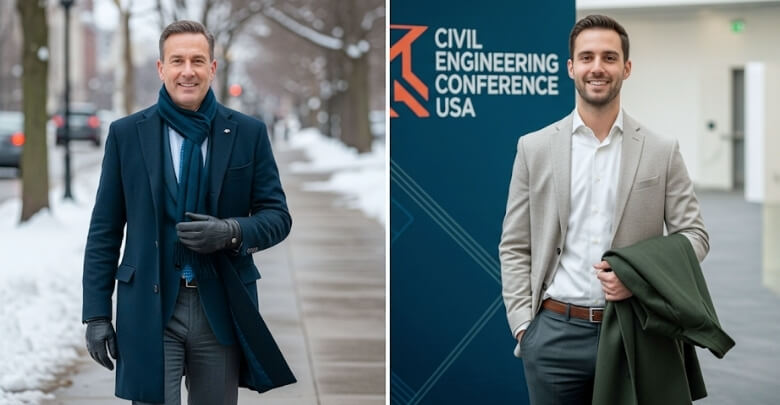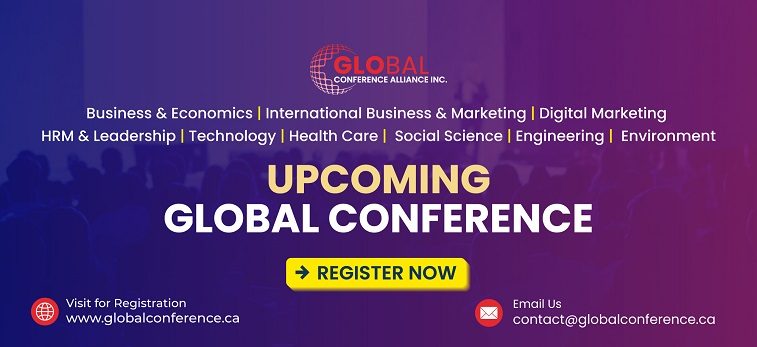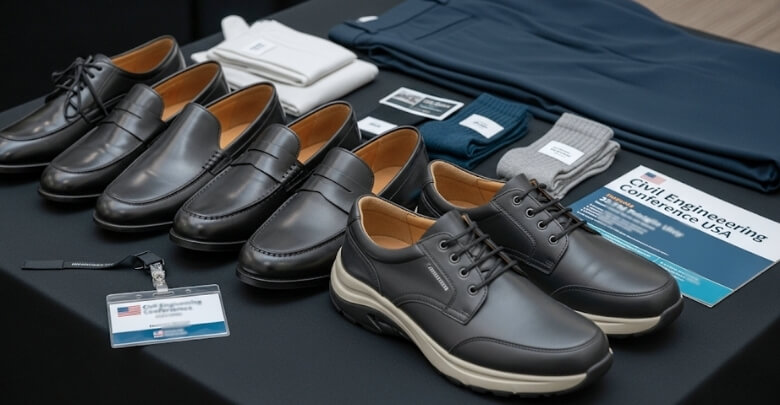Are you attending a civil engineering conference in the USA? These events are great for meeting people, learning new things, and sharing ideas. But knowing what to wear is also important. You want to look neat and feel comfortable all day.
So, what to wear to a civil engineering conference in the USA?
Wear business casual or formal clothes to a civil engineering conference in the USA. Men can put on a shirt, pants, and clean shoes. Women can wear a blouse, skirt, or pants, and flats or heels. Bring a jacket or sweater for cold rooms. Choose comfy shoes and carry a neat bag.
Keep reading to learn more simple and smart outfit tips for your next conference.
What to Wear to a Civil Engineering Conference in the USA?
| Attire Type | Men | Women |
| Business Formal | Suit, dress shirt, tie, dress shoes | Suit or fitted dress with blazer, closed-toe shoes |
| Business Casual | Collared shirt, dress pants/chinos, loafers | Blouse, slacks/skirt, blazer/cardigan, flats/heels |
| Comfort Tips | Bring layers, comfortable shoes, briefcase | Layer with a cardigan, wear comfortable shoes |
| Avoid | Jeans, sneakers, graphic tees, shorts, flashy jewelry | Athletic wear, revealing clothes, sandals, and flashy jewelry |
Dressing right for a civil engineering conference helps you feel confident and look professional. Most events are business casual. You want to stay comfortable during long hours while making a good impression. Choosing smart outfits keeps you prepared for all kinds of sessions and networking chances. Here is what you can wear to the conference:
Business Casual for Men
Men should wear collared shirts like button-ups or polos in solid colors or simple patterns. A sport coat or blazer adds polish but isn’t required at all conferences. Dress pants, chinos, or khakis are best—avoid jeans unless clearly allowed. Complete the outfit with loafers, clean dress shoes, or neutral sneakers.
Simple extras help finish the look. A belt and watch make your outfit feel more put-together without much effort. A tie is fine but totally optional, depending on the conference tone. Carry a neat briefcase or bag to hold your schedule, notebook, and other essentials.
Business Casual for Women
Women should go for neat blouses, fitted tops, or sweaters in calm, professional colors. A blazer or cardigan can add style and keep you warm in chilly rooms. Pair these with dress pants, skirts that go below the knee, or tailored dresses. Avoid wearing jeans or leggings, especially if no casual dress code is given.
Footwear should be smart but also comfortable for walking between sessions. Choose flats, low heels, or polished boots in neutral colors. Add simple jewelry or a scarf to personalize your outfit without overdoing it. A structured tote or small bag is helpful for carrying materials and staying organized.
Matching Your Outfit to the Event Style
Not all conferences feel the same—some are more formal, while others feel more relaxed. Check if the conference provides a dress code or guidance in the event details. For example, events at universities may lean casual, but those at hotels or city venues may feel dressier. You’ll want to adapt your outfit to fit the tone and setting.
If you’re attending one of the upcoming conferences in USA, remember to check the venue and session types ahead of time. Outdoor tours or site visits might need weather-friendly gear or sturdy shoes. Indoor presentations usually stay chilly, so layers help a lot. It’s all about balancing comfort with looking sharp.
Smart Accessories
A few smart accessories can improve your look and help you feel more prepared. Men and women alike should stick with clean, simple styles that won’t distract. Keep your watch, jewelry, or scarf minimal and match them with the rest of your outfit. Don’t forget to carry a pen, notepad, and business cards, if you have them.
Make sure your bag or case looks neat and fits everything you need without looking bulky. Pack a phone charger, breath mints, and maybe a snack for breaks. Plan for changes in temperature—conference rooms often feel cold even during warmer months. Looking prepared shows you’re serious, even before you speak.
Why Does Your Outfit Matter at a Professional Conference?
When it comes to choosing what to wear at a professional conference, it’s not just about looking good. The right clothes help you connect, feel at ease, and leave a strong impression. Here are the core reasons your outfit really matters at these events.
First Impressions Count
- People will see your clothing before you even say a word, so it shapes their first idea of you. A polished look can show that you take your work and the event seriously.
- When you choose neat and proper attire, others feel you respect the meeting and everyone in it. Looking prepared shows you value both the opportunity and the people you meet.
Confidence Builder
- Wearing clothes that fit well and suit the occasion can give you a boost of self-assurance. You’ll find it easier to speak up, introduce yourself, and join in discussions.
- The right outfit can help you feel more comfortable and at home among new faces and big crowds. Feeling confident will make your time at the event much more enjoyable.
Networking Power
- The right look can encourage other professionals to start a conversation with you at the conference. When you dress well, people may see you as reliable and open.
- A smart outfit helps you mix with peers, leaders, and even future work partners in a natural way. You might find it easier to connect and build useful relationships.
Reflects Your Organization
- When you attend as part of a company, your outfit helps show your employer’s values to others. A tidy look can leave a positive mark and build trust.
- Colleagues and clients may judge your company based on how you present yourself at public events. Wearing the right clothes shows you care about your team’s image.
Fitting the Conference Culture
- Each event has its own dress code, even if it’s not written down. Choosing the wrong outfit can make you feel awkward or left out.
- Dressing to match the conference style tells others you understand the group’s standards. Fitting in makes it easier to focus on learning and meeting people.
Practical Benefits
- Long days, lots of walking, and cold rooms mean comfort is key at conferences. Good clothes help you handle changes in temperature and activity levels.
- Picking practical shoes and easy layers means you’ll stay focused on the sessions, not on feeling too hot or cold. Comfort lets you learn and network without distractions.
How to Balance Comfort and Professionalism at a Civil Engineering Conference?
What you wear to a civil engineering conference can make a big difference. You’ll be networking, moving around, and attending sessions for hours, so your outfit needs to be both comfortable and professional. Choosing the right clothes helps you stay at ease while still making a strong impression. Here’s how you can find a balance between looking sharp and feeling good.
Pick Smart Clothes
Choose clothes that fit well but don’t feel tight or itchy. Dress pants or neat slacks with a clean shirt or polo always work well. For girls, a nice blouse with pants or a skirt is a good choice. These outfits look proper but let you move around easily. You’ll look respectful without feeling uncomfortable.
Wear Light Layers
Conference rooms can be cold one minute and warm the next. It’s smart to bring a light sweater or jacket you can take off easily. Try to match it with your outfit so it still looks neat. Layers help you stay comfy all day without needing to change clothes. Plus, they’re easy to carry if you don’t need them.
Choose Good Fabrics
Clothes made from cotton or soft fabric feel better for long hours. Some materials also stay smooth and don’t wrinkle easily. You won’t need to keep fixing your shirt or pants every time you sit or stand. If it’s a long day, that helps a lot. Try to avoid itchy or very thick clothes.
Comfortable Shoes Matter
You’ll walk from room to room, stand in lines, and maybe even go outside. So, wear shoes that feel soft and fit well. Flat shoes, loafers, or clean sneakers can work if they look neat. Try not to wear brand-new shoes unless you’ve worn them before. That way, you won’t get blisters or sore feet.
Keep It Simple
Don’t wear very bright or shiny things that draw too much attention. Simple jewelry and a neat hairstyle are always a safe choice. Bring a bag that fits your stuff and doesn’t hurt your shoulder. You’ll need space for things like a notebook, phone charger, or snacks. Keeping it all clean and simple helps you focus.
Dress Code Check
Before the conference, it’s smart to see if there’s a dress code or clothing advice. Some events may be more formal, while others are relaxed. If you’re unsure, dressing business casual is usually a safe bet. One helpful tip is to check the engineering conference dress code if it’s shared on the event website. That way, you won’t feel out of place when you arrive.
Ready for Any Moment
If you’re talking in front of others or joining meetings, wear something that makes you feel confident. Your clothes should still be comfy but also neat and tidy. Make sure your outfit doesn’t wrinkle too much or feel too hot under lights. When you look and feel good, it’s easier to smile, listen, and talk to others. Little details like this make a big difference.
What Accessories Should You Consider for a Polished Look?
Looking neat at a conference doesn’t just mean nice clothes—it also includes the right accessories. Small details can make a big difference. The right items help you stay organized, comfortable, and ready for anything. Here are some simple things you can use to complete your outfit.
- Simple Watch: A clean, easy-to-read watch keeps you on time without checking your phone often during sessions or meetings.
- Neat Bag: Carry a tote, backpack, or case that fits your things and looks tidy without being too bulky or flashy.
- Clean Belt: A matching belt adds shape to your outfit and keeps your pants in place during long walks or full-day sessions.
- Plain Jewelry: Pick basic earrings, a small bracelet, or necklace that doesn’t shine too much or make noise when you move.
- Scarf or Wrap: Choose a light scarf that adds color and keeps you warm if rooms get chilly or the weather changes quickly.
- Notebook and Pen: Bring a small notebook and pen so you can write notes or ideas without needing to pull out a device.
- Breath Mints: Keep breath mints in your pocket or bag so you feel fresh and confident while talking to new people all day.
How Do Weather and Venue Impact Your Clothing Choices?
It is important to take into account both the weather and the venue when choosing what to wear to a professional conference. These factors determine how comfortable—and how professional—you appear throughout the event.
Weather Considerations
Here are the weather considerations you should keep in mind while choosing attire for the conference:
Temperature and Season
- Hot Weather (Summer):
- Select breathable, lightweight fabrics such as cotton, linen, or silk to stay cool.
- Consider lighter colors to reflect sunlight.
- Avoid heavy synthetic fabrics like polyester or rayon, as they retain heat and odors.
- Wear moisture-wicking undergarments or undershirts to minimize sweat marks.
- Always bring a lightweight layer like a cardigan or blazer for chilly indoor air conditioning.
- Cold Weather (Winter):
- Layer clothing for warmth: base layers under dress shirts, sweaters, or blazers.
- Choose warm, professional outerwear such as an overcoat, peacoat, or trench for outdoor journeys.
- Select thick socks or tights and insulated, professional footwear—cold feet are a common comfort issue.
- Wet or Unpredictable Weather:
- Have an umbrella or a raincoat on hand for rain.
- Water-resistant shoes and quick-drying layers help prevent discomfort from sudden downpours.
Adjusting to Climate Shifts
- Spring and fall can be unpredictable—layering is essential for comfort with temperature swings.
- Accessories like scarves offer both style and practicality.
Venue Influences
Here’s how a venue of the conference can influence your attire choice:
Indoor Venues
- Air Conditioning: Conference rooms are often kept cool, so layering ensures you can adapt to unpredictable indoor chills.
- Lighting and Layout: Larger rooms or exhibition halls might require walking or standing. Prioritize comfortable and professional shoes.
- Dress Code: Formality can vary; review the location’s typical dress requirements. High-end hotels or convention centers tend to expect formal business attire, whereas creative or startup arenas may allow slightly more relaxed outfits.
Outdoor or Mixed Venues
- Weather exposure may be greater at events held partly outdoors (exhibitions, networking sessions, campus venues).
- Sun protection becomes important—consider sunglasses, hats, or light scarves (if they fit within the event’s professionalism standards).
- Outdoor or semi-outdoor venues may require more durable or practical footwear.
Geographic and Cultural Context
- Some regions or venues may have unique expectations; international or culturally themed conferences may encourage or require certain attire—always check event details in advance.
Are There Specific Clothing Items to Avoid During a Civil Engineering Conference?
Yes, there are definitely some clothing items you should avoid during a civil engineering conference. The right clothes help you fit in, feel confident, and show respect for the event. Wearing something too casual or distracting can give others the wrong impression. Following some simple rules makes it easier to look your best all day.
Too Casual Clothing
T-shirts and ripped jeans may seem comfortable, but they look out of place at most conferences. Athletic wear or shorts do not match the professional vibe most events require. Better to choose slacks or dress pants instead of anything too relaxed. Dressing too casually can make you stand out for the wrong reasons.
Bright or Loud Prints
Shirts and dresses with very loud colors or big patterns grab too much attention at formal events. Plain colors or simple patterns keep the focus on you, not your clothes. Overly bright designs may distract people during your talks or meetings. Neutral tones work well for almost every session.
Uncomfortable Shoes
High heels, new shoes, or sandals may cause pain if you walk or stand a lot. Practical shoes help you focus on the event, not your feet. Make sure your shoes feel good all day, even on stairs. Comfortable footwear should always be on your packing checklist for civil engineering conference in the USA.
Wrinkled or Dirty Clothes
People may notice wrinkles, stains, or holes quickly in professional settings. Fresh, clean clothes help you feel ready for any meeting. Always check your outfit for spots or marks before you leave the hotel. Neat clothes show you care about your appearance and your work.
Overdone Accessories
Big jewelry, noisy bracelets, or flashy belts can be distracting when talking to others. Simple, small pieces look polished and do not take away from your message. Heavy scents may also bother people in close rooms or groups. Stick with basics to keep things easy and pleasant for everyone.
Weather-Inappropriate Items
Thin tops or short sleeves might leave you cold in air-conditioned rooms or windy weather. Heavy sweaters may make you too warm indoors during summer. Bring a light jacket or cardigan so you can adjust quickly. Always check the forecast before packing your outfits for the trip.
How Does the Dress Code Vary Between Casual, Business Casual, and Formal in This Context?
Dress codes at a civil engineering conference can look very different depending on the event’s style and location. Some meetings may allow relaxed clothing, while others expect a business casual or formal appearance. Each dress code sets a certain tone and shows how people should present themselves. Here are the key differences in dress codes and what to expect based on the event:
Casual Attire
Casual dress often means comfortable clothes like jeans, t-shirts, and simple sneakers or sandals for walking. Bright colors and bold patterns usually feel fine at casual events. You might see people wearing hoodies or sweatshirts in more relaxed spaces. These choices work for informal group sessions or outdoor activities.
Business Casual Look
Business casual dress combines neat pants or skirts with a button-down shirt or smart blouse for a polished appearance. Clean, simple shoes like loafers or flats finish off the outfit without being too formal. Soft, neutral colors and subtle prints are easy picks for these events. This style feels right for most conference days and networking events.
Formal Attire
Formal dress requires a suit, dress shirt, and sometimes a tie or elegant dress, with everything matching and ironed. Polished shoes and a belt should complete the outfit, showing you are ready for serious business. Dresses and skirts for women should fall below the knee or have a classic shape. Strong, simple accessories add to the look without taking away from it.
Event Expectations
Some events give clues about what to wear in their invitation or conference guide, so always check these before packing. Sessions with speakers or awards might require more formal outfits than regular meetings. If you are unsure, business casual is a safe middle ground. Dressing like most other guests helps you feel comfortable and welcome.
Location and Activities
If the conference takes place outside or involves site tours, casual and practical clothes are usually allowed and needed. For indoor talks or hotel meetings, business casual or formal dress is expected. Weather, season, and even the city matter when choosing what to pack. Always think about what you will do each day before deciding on an outfit.
What Footwear Options Are Best for Attending a Civil Engineering Conference?
Attending a civil engineering conference means walking around, standing a lot, and maybe even going outside. Your feet will be busy the whole day, so your shoes really matter. Wearing something uncomfortable can ruin your focus and mood. Here are the best shoe options to stay comfortable and confident all day.
Comfortable Dress Shoes
Dress shoes can look nice and still feel good if you pick the right ones. Look for ones with soft insides and a flat heel. Too-stiff shoes can hurt your feet before the day is even halfway done. Try to walk in them at home before the event. That way, you know they won’t give you blisters.
Smart Flats
Flats are a good choice if they are soft and give your feet enough support. You don’t want shoes that slide off or pinch your toes. Closed-toe flats look neat and work well with many outfits. Make sure the soles have some grip so you don’t slip. Try to avoid very thin or hard soles.
Clean Sneakers
Some conferences allow neat, simple sneakers if they look tidy and not too sporty. These are great for long days and lots of walking. Avoid very bright or flashy ones—stick to calm colors like black or white. Just make sure they match your clothes and look clean. Dirty or worn-out shoes don’t make a good impression.
Low Heels
If you wear heels, keep them low and easy to walk in. You don’t need to be uncomfortable to look nice. Avoid thin heels that get stuck in the floor or make noise. A short, thick heel gives better balance and comfort. Try not to wear heels that are new or untested.
Weather-Friendly Options
Think about the weather before choosing your shoes. If it might rain, avoid suede or open shoes that soak easily. Boots can work if they look clean and match your clothes. Bring an extra pair just in case you need to switch. It’s better to be ready than stuck with wet feet.
Slip-On Styles
Slip-on shoes are easy to wear and save time when getting ready. Some styles even look fancy without needing laces. Make sure they don’t feel loose while walking. Good slip-ons hug your feet but don’t press too hard. They’re a good pick if you’re moving between rooms all day.
Cushioned Support
Always check if the shoes feel good inside. Soft padding and arch support help you feel better by the end of the day. Conferences can be long, so your feet will thank you later. Bring shoe pads if your favorite pair is a little too hard. Even a small cushion can make a big difference.
FAQs about Outfit for Civil Engineering Conference in the USA
First-time attendees to civil engineering conferences in the USA may find it hard to decide what to wear. There are many little things to think about beyond just looking good. These FAQs help clear up common questions to make dressing easier.
Can I Wear Cultural or Traditional Clothing?
Yes, you can wear cultural or traditional clothing as long as it looks neat and respectful in a professional setting. Pair it with simple shoes and tidy grooming. Many conferences appreciate cultural diversity. Just be sure it’s comfortable for long hours.
Is It Okay to Wear Branded Company Shirts?
Yes, branded shirts with small, clean logos can work well, especially if you’re representing your company. Avoid oversized logos or loud designs. Keep the rest of your outfit simple and neat. A branded shirt looks better when tucked in and wrinkle-free.
Should I Bring a Backup Outfit?
Bringing a backup outfit is smart, especially if you’re attending multiple days or events. Accidents, spills, or weather can ruin clothes. Having an extra shirt or pair of pants helps you stay ready. Keep a backup in your bag or hotel room.
What Should I Wear for an Evening Conference Dinner?
Evening dinners may require dressier clothes than daytime sessions. A blazer, simple dress, or dark slacks often works well. Avoid casual outfits like jeans and sneakers. Check the invite or ask someone if you’re unsure about the expected style.
Can I Wear Short Sleeves or Sleeveless Tops?
Yes, short sleeves are fine as long as the top looks clean and professional. Sleeveless tops should cover well and fit properly. If the weather or venue is cold, bring a light jacket. Neatness and comfort are more important than sleeve length.
Are Jeans Ever Acceptable at a Conference?
Jeans are usually not recommended unless the event clearly allows casual wear. If allowed, choose dark, clean, and fitted jeans. Avoid rips, frays, or baggy styles. Pair them with a smart shirt or blazer to keep the look professional.
What Type of Outerwear Should I Bring?
Choose a jacket or coat that’s simple, warm, and easy to carry. Conference venues often have changing temperatures or outdoor spaces. Neutral colors like black or gray match well with most outfits. Avoid heavy coats unless the weather truly requires it.
Can I Wear Makeup and Nail Polish?
Yes, light makeup and neat nail polish are totally fine. Go for natural shades that match a professional look. Avoid strong colors or glitter for formal settings. Clean, well-kept hands and faces always help with a polished appearance.
Are Hats or Head Coverings Allowed Indoors?
Head coverings worn for cultural or religious reasons are perfectly fine. For fashion hats, it’s better to avoid them indoors. They can seem too casual or block others’ views. Stick with clean hair or a neat hairstyle instead.
What Should Students Wear When Presenting a Project?
Students presenting a project should dress neatly to make a good impression. A button-down shirt, slacks, or a simple dress works well. Avoid flashy clothes or overly casual outfits. Looking clean and confident helps people focus on your work, not your clothes.
Final Thoughts
It is important to wear the right clothes for a civil engineering conference. Good clothes help you feel comfortable, meet new people, and look neat all day. When you think about what to wear to a civil engineering conference in the USA, remember to pick business casual or formal outfits and wear comfortable shoes.
Bring a sweater or jacket if it might get cold. Keep your look simple and tidy. This way, you will feel confident, make a good impression, and enjoy your time at the conference.

